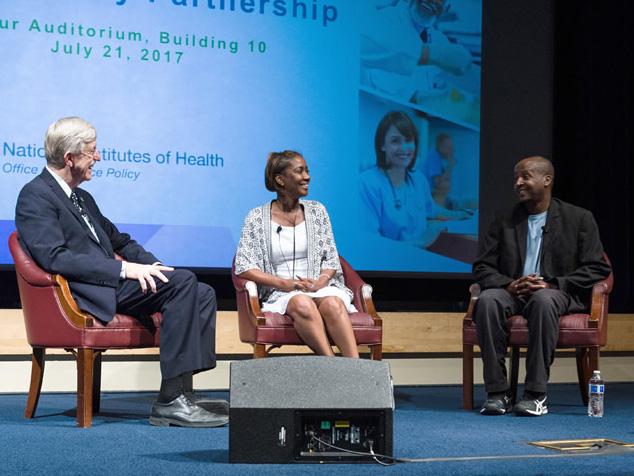The NIH Bethesda campus recently welcomed several special guests for a presentation titled Given a Voice: Update on the NIH–Lacks Family Partnership.
Henrietta Lacks’ grandchildren Jeri Lacks-Whye (who is also the Lacks family spokesperson) and David Lacks, Jr. came to speak with NIH Director Francis S. Collins, Ph.D., M.D. about the importance of protecting patients and their families.
Following the publication of Lacks’ complete genome in 2013 by German researchers, patient advocates and bioethicists became concerned that it violated the Lacks family’s privacy, as the potential to identify the family’s risk of disease now existed.
When the Lacks family contacted German researchers with their concerns, the data were removed from public view. This prompted Collins and NIH Deputy Director for Science, Outreach, and Policy Kathy L. Hudson, Ph.D. to reach out to the family and meet over several months. Collins and Hudson wanted to understand the family’s perspective and create a dialogue that could help develop new policies to protect their privacy while still allowing for scientific advancement.
“We were often in the dark regarding the use of her cells, we usually found out after the fact, through the media,” said David Lacks. “We wanted the ability to engage with the research community as participants. Our goal was preserving scientific advancement and just being part of the conversation.”
Regarding their first meeting with Collins, Jeri said, “It was an honor that they wanted to sit down with the family and listen to our concerns. It has been a great journey to embark on, and we’ve learned more about our grandmother’s story. Our goal was to bridge the gap between research participants and researchers.”
In 1951, Henrietta Lacks was being treated for cervical cancer at Baltimore’s Johns Hopkins Hospital. Doctors extracted cells from her tumor sample without her knowledge or consent for further research. At the time, there were no federal regulations or restrictions on the use of patients’ cells in research.
Although Lacks died shortly afterwards, scientists kept her cancer cells alive and replicating, and they became the first human cells cultured continuously for use in research.
HeLa cells “have been an important reagent for my research since the beginning, since they pre-date my first ventures into science in the early 1980s,” said Stephen Anderson, Ph.D., senior principal investigator, Molecular Immunology Section, Cancer and Inflammation Program. “I have always been interested in the molecular biology of the gene, and key early tools, such as in vitro transcription and RNA splicing extracts, were made from HeLa cells. We currently have them growing in the lab, since they readily take up foreign DNA and they have very high transcriptional activity, making them the perfect control for our studies of regulatory elements controlling gene expression.”
The Lacks family and the NIH reached a solution that included the creation of the HeLa Genome Data Access Working Group, of which David and Jeri are members. Researchers must request access to the whole genome through the committee and must be pursuing health, medical, or biomedical research.
“Being on the committee has allowed me to become even more engaged, and I dove into the books to learn more,” said David. “It’s rewarding and gratifying to see how far we’ve come. We always found out after the fact. Our concerns weren’t about stopping science, just about opening up communication and knowing beforehand.”
The controversy surrounding the HeLa cell line is unique because the identities of both Henrietta and her descendants are public knowledge. Because her cells were the first human cells cultured continuously for use in research, Lacks’ identity was revealed in a scientific journal in 1971. She was also the subject of a BBC documentary in 1997 as well as the bestselling book The Immortal Life of Henrietta Lacks in 2010. As a result, the Lacks family has been thrust into the spotlight.
But, as Jeri put it, “Now we’re at the table, making decisions.”
The presentation at the Bethesda campus was followed by a Q&A session, with many researchers young and old expressing their gratitude for Henrietta’s contribution to science and the family’s openness and willingness to work with researchers.


